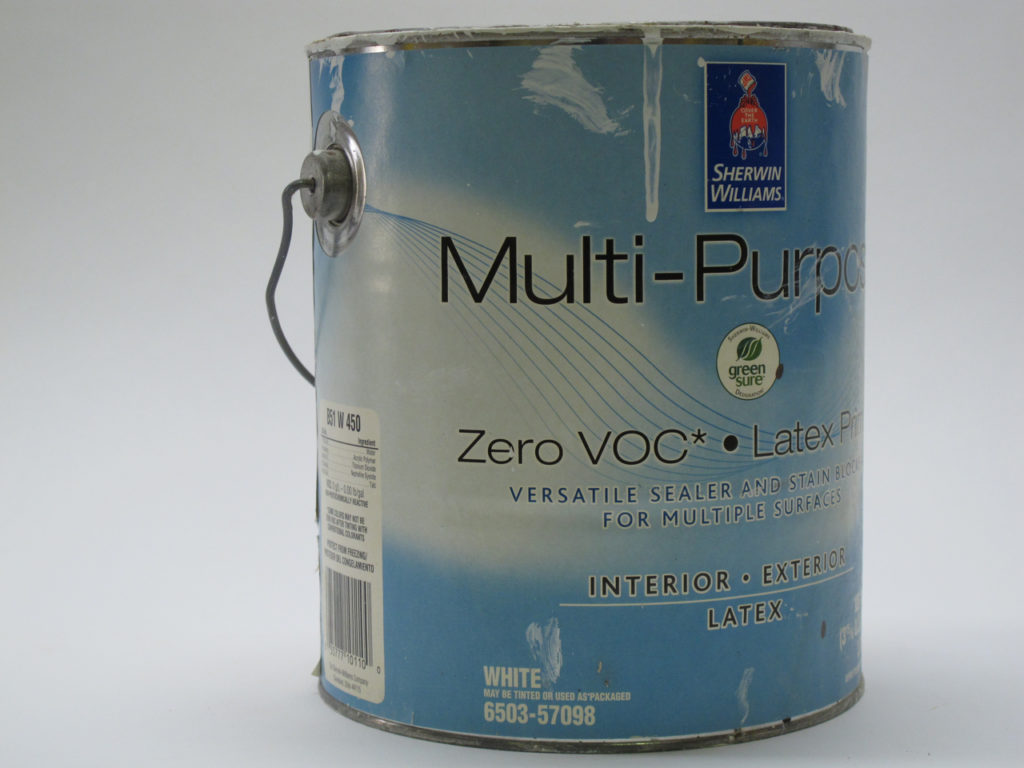We may receive a commission when you use our affiliate links. However, this does not impact our recommendations.

This paint can from Sherwin-Williams is several years old. The company has agreed to stop making these claims because they aren’t true.
Ever since water-based paints and finishes began carving out a market for replacing solvent-based products, claims for the amount of solvent these products contain have been getting increasingly lower. That is, until a few years ago when some products actually began claiming zero VOCs.
I’ve been suspicious of this claim ever since I first saw it. Even though resin manufacturers have been getting better at making resins that form a film with less and less solvent, getting to zero solvent has always seemed unlikely to me, especially with the pigment used in paint.
Apparently, I wasn’t the only one to question these marketing claims. The Federal Trade Commission (FTC) has just settled with four paint companies: Benjamin Moore, ICP Construction, YOLO Colorhouse and Imperial Paints, who have agreed to orders to stop making these claims unless they can prove them.
Furthermore, the FTC required Benjamin Moore and ICP Construction to remove the environmental seals of approval from their cans. It turned out that they had awarded these seals of approval to themselves. That’s kind of like claiming a product has been voted the best. Voted by whom. The office workers?
Similar settlements for falsely claiming zero VOCs had already been made several years ago with Sherwin-Williams and PPG Architectural Finishes.
When the FTC reaches a consent order, as in these cases, it applies only to future actions and carries a civil penalty of up to $40,000 for each violation. The FTC works to promote competition and to protect and educate consumers.
Now if you’ve been following my writings, you know that I don’t have a problem using coatings that contain solvents (as long as you protect yourself with good air movement, as with a spray booth). But you also know that I have a big problem with manufacturers who deceive in their advertising and labeling. Good for the FTC.
– Bob Flexner
Here are some supplies and tools we find essential in our everyday work around the shop. We may receive a commission from sales referred by our links; however, we have carefully selected these products for their usefulness and quality.









I, too, fought the battle against misleading use of the Zero VOC term, albeit with adhesives used to install flooring materials. Our product got some undeserved bad press years ago about VOC emissions; history has shown that it actually was quite good even then. We attempted to get the adhesive folks to gain control of their VOC emissions. They constantly claimed they had zero VOC’s. They simply could not understand the difference between what was poured into the can and what was emitted from the product after application, which is what really counts.
The Zero VOC issue stems from a California South Coast Air Quality Management District smog control regulation that prohibited a list of about a dozen photochemically reactive compounds (its much more complex today). Anything not on that list was exempt and they could use as much as desired and still define the product as “Zero VOC” under that reg. At that time there was a limit, I recall it being 0.1%, of the regulated compounds that could still be in the product, so some used 0.09% of each and still called it Zero VOC.
From the human health perspective, emission rate is the important factor, not content. ER can be used to model concentration in a building, given volume and an air exchange rate. ER is expressed as mass emitted per unit area per hour, measure at a specified time after application; our certification program used mg/m2/hr., with the initial limit for total VOC set at 1000mg/M2/hr. When we surveyed products from across the industry, we found one that emitted 30,000 mg/m2/hr, and was labelled “Zero VOC” !!!! The manufacturer simply could not understand the problem! They have it under control today.
The problem is that I still see products labelled Zero VOC,which is very misleading to consumers and specifiers of materials trying to keep chemical exposure low.
Rottenstone is available on Ebay UK from a seller called ‘endlessgreen’ – seems to be a sensible price for a sensible quantity, unlike $42 for 1 lb from a US supplier! It appears to be £6.25 for 250 g and £2.50 postage…
http://www.ebay.co.uk/itm/Rottenstone-Fine-Abrasive-Powder-For-Shellac-amp-French-Polishing-250g-/170942397218?
Hope this post doesn’t contravene posting regulations!
Well there is an ‘*’ after the ‘Zero VOC’, to me this means there are exceptions in the fine print.
Either case, most paint manufacturers have lowered the VOC a lot, but as Bob mentions in the article you need some solvent to make the paint film and some VOC is not zero VOC.
Hi Bob,
This is a bit of a kamikaze comment, related to a soap finish piece you made … seven years ago! I live in Copenhagen and want to refinish a table l think has a soap finish. I have two questions:
1. How can l tell if the finish is completely removed? I plan to
Refinish with oil-based polyeurethane; is this stuff forgiving if some
Soap residue remains? Is it helpful to scrub the bare wood repeatedly with plain water?
My father introduced me to the wonders of rottenstone, a fine black powder that turns a finish to silk. Do you (or your wife) have any idea if this stuff is availavle in Denmark, or what it might be called?
Thank you!